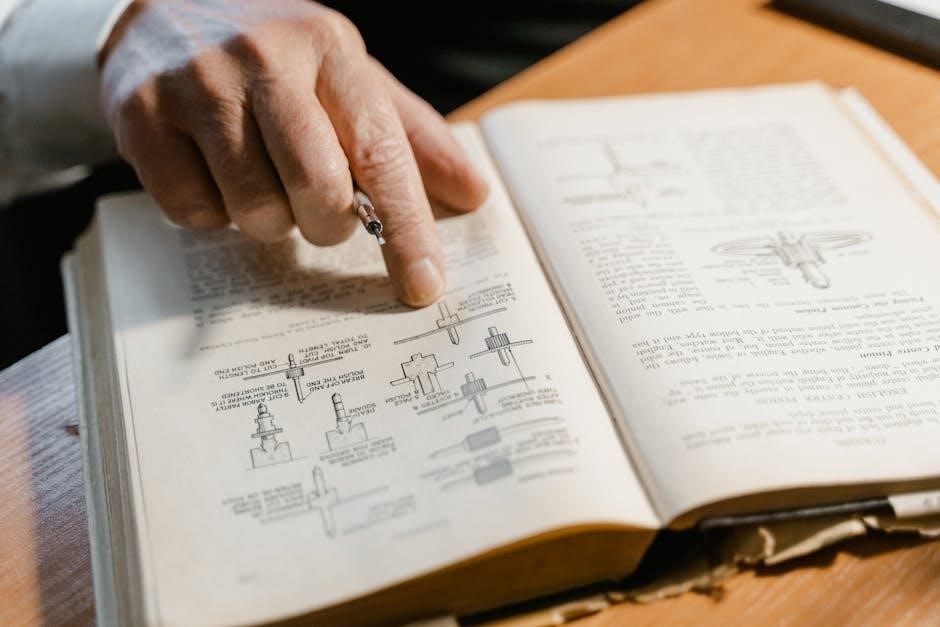The Kenwood 7400 receiver is a high-quality audio device known for its robust build and exceptional performance. It features excellent AM/FM tuners and is a favorite among audio enthusiasts.
1.1 Overview of the Kenwood 7400 Receiver
The Kenwood 7400 receiver is a high-performance audio device designed to deliver exceptional sound quality and versatility. Known for its robust build and user-friendly interface, it is a popular choice among audiophiles and hobbyists. The receiver supports both AM and FM tuning, offering clear and precise radio reception. With a power output of 75 watts per channel, it ensures strong and consistent sound delivery; The unit also features a range of connectivity options, making it compatible with various external devices. Its tone controls and equalizer settings allow for personalized audio adjustments. The Kenwood 7400 is praised for its reliability and durability, making it a long-lasting addition to any home audio system. A detailed service manual is available for advanced users, providing insights into its internal workings and maintenance.
1.2 History and Development
The Kenwood 7400 receiver has a rich history, dating back to its development as a high-quality audio component. Known for its reliability and performance, it has become a favorite among Kenwood enthusiasts. The receiver was designed to deliver excellent sound reproduction and durability, making it a popular choice for home audio systems. Over the years, Kenwood has refined its design and functionality, ensuring the 7400 remains a standout model. Service manuals and section level diagrams were introduced to aid in maintenance and repairs, showcasing Kenwood’s commitment to user support. The receiver’s development emphasizes quality and longevity, with many units still operational decades after their release. Its enduring popularity is a testament to Kenwood’s dedication to creating superior audio equipment. The 7400 continues to be celebrated for its robust build and exceptional performance, solidifying its place in the history of home audio technology.
1.3 Key Benefits and Features
The Kenwood 7400 receiver offers a range of impressive features that make it a standout choice for audio enthusiasts. With its robust build and exceptional performance, it provides crystal-clear sound reproduction. The receiver is equipped with excellent AM/FM tuners, ensuring a wide range of radio station reception. Its user-friendly interface and durable construction make it a reliable option for home audio systems. Additionally, the 7400 supports various connectivity options, allowing users to integrate external devices seamlessly. The availability of service manuals and section level diagrams further enhances its appeal, providing users with detailed guidance for maintenance and repairs. These features, combined with Kenwood’s reputation for quality, make the 7400 a preferred choice among audiophiles. Its longevity and performance have solidified its place in the market, offering a blend of functionality and reliability that meets the needs of discerning users.

Features and Specifications
The Kenwood 7400 receiver delivers 75 watts per channel into 8 ohms, featuring a 20 Hz–20 kHz frequency response and 70 dB signal-to-noise ratio for clear audio reproduction.
2.1 Power Output and Channels
The Kenwood 7400 receiver is designed to deliver exceptional audio performance with a power output of 75 watts per channel into 8 ohms. This ensures clear and powerful sound reproduction across various speaker configurations. The receiver supports multiple channels, making it suitable for both stereo and surround sound systems. Its stable power output guarantees consistent performance, even at high volume levels. The unit is optimized for 8-ohm speakers, providing a balanced and efficient listening experience. Users can expect precise control over each channel, ensuring that every detail in the audio is faithfully reproduced. This robust power output and channel flexibility make the Kenwood 7400 a reliable choice for both home audio enthusiasts and professionals alike.

2.2 Frequency Response and Signal-to-Noise Ratio
The Kenwood 7400 receiver offers a wide frequency response range of 20 Hz to 20 kHz, ensuring accurate and detailed sound reproduction across the entire audible spectrum. This makes it ideal for both music and radio listening, providing clear bass, midrange, and treble. The signal-to-noise ratio is an impressive 70 dB for AM and 90 dB for FM, minimizing background noise and delivering a clean listening experience. These specifications highlight the receiver’s ability to maintain audio fidelity while reducing unwanted interference. Whether tuning into your favorite radio station or playing music from connected devices, the Kenwood 7400 ensures a balanced and immersive sound. Its strong performance in both frequency response and noise reduction makes it a standout choice for audiophiles seeking high-quality audio reproduction.
2.3 Connectivity Options
The Kenwood 7400 receiver offers a variety of connectivity options to ensure seamless integration with your audio system. It features multiple RCA inputs, including Phono, CD, and Auxiliary ports, allowing you to connect a wide range of external devices such as CD players, turntables, and auxiliary audio sources. The receiver also includes gold-plated RCA jacks for optimal signal transfer and reduced interference. For speaker connections, the unit provides robust binding posts that support 4-16 ohm speakers, ensuring compatibility with most home audio setups. Additionally, the receiver includes AM and FM antenna terminals, enabling clear radio reception. These connectivity options make the Kenwood 7400 a versatile and user-friendly component for building or upgrading your home audio system. Its thoughtful design ensures that you can easily connect all your audio gear and enjoy high-quality sound reproduction.

Installation
Careful unpacking and inventory ensure all components are present. Place the receiver in a well-ventilated area, away from direct sunlight, and follow power setup instructions precisely.
3.1 Unboxing and Inventory
Begin by carefully opening the box and inspecting the Kenwood 7400 receiver for any visible damage. Ensure all components, including the receiver, power cord, remote control, and user manual, are included.
Verify the inventory list provided in the manual to confirm no items are missing. If any discrepancies are found, contact Kenwood customer support immediately for assistance.
Gently remove the receiver from its packaging and place it on a stable, flat surface. Take note of any protective covering on the unit, which should be removed before operation.
Organize all accessories and cables to prevent misplacement. Store the original packaging in a safe location in case you need to move or store the receiver in the future.
3.2 Placement and Environment
Proper placement and environmental conditions are crucial for optimal performance of the Kenwood 7400 receiver. Choose a stable, flat surface to ensure the unit remains level and secure. Avoid exposing the receiver to direct sunlight, moisture, or extreme temperatures, as this may damage internal components.
Keep the receiver away from magnetic fields and other electronic devices that could cause interference. Ensure adequate ventilation to prevent overheating, as this can affect sound quality and longevity. Avoid placing the unit in confined spaces without proper airflow.
Position the receiver in a location that minimizes vibration and movement. If using in a vehicle, secure the unit firmly to prevent damage during transit. Maintain a clean, dust-free environment to preserve functionality and audio clarity.
Follow these guidelines to ensure the Kenwood 7400 receiver operates efficiently and delivers exceptional audio performance for years to come.
3.3 Power Connection and Setup
Ensure the Kenwood 7400 receiver is connected to a stable power source to guarantee reliable operation. Use a 15 Volt AC power supply, as specified in the manual, to avoid damage to the unit. Connect the power cord securely to both the receiver and the electrical outlet.
Before powering on, verify that the receiver is set to the correct voltage according to your region. If using the receiver in a vehicle, ensure the power and remote turn-on wires are correctly connected to the vehicle’s electrical system. Avoid overloading the circuit to prevent electrical issues.
Once connected, turn on the receiver and allow it to initialize. Use the remote control or front panel to adjust settings as needed. For proper functionality, ensure all connections are secure and free from interference.
Refer to the manual for specific power requirements and troubleshooting steps if issues arise during setup.

Operating the Receiver
Operate the Kenwood 7400 using its intuitive controls. Adjust volume with the knob, navigate menus with the buttons, and select input sources like AM, FM, or auxiliary devices.
4.1 Basic Controls and Functions
The Kenwood 7400 receiver features a user-friendly interface with essential controls for seamless operation. The volume knob adjusts the output level, while the tuning dial allows precise selection of AM/FM stations. The power button switches the unit on/off, and the input selector enables switching between connected devices like CD players or auxiliary sources. The display provides clear feedback on the current mode, station frequency, or input source. Additional functions include a mute button to temporarily silence the output and tone controls for adjusting bass and treble levels. These controls ensure intuitive navigation and customization of your listening experience. By familiarizing yourself with these functions, you can easily operate the receiver and enjoy high-quality audio playback from various sources.

Tuning Into Radio Stations
Tuning into radio stations on the Kenwood 7400 is straightforward. Use the tuning dial for precise station selection, ensuring clear AM and FM reception with minimal interference.
5.1 AM Radio Tuning
Tuning into AM radio stations on the Kenwood 7400 receiver is a simple process. Start by pressing the FM/AM button to select the AM mode. Use the tuning dial to find your desired station, adjusting carefully for clear reception. AM signals can be more susceptible to interference, so ensure the antenna is properly connected. For optimal results, an external AM antenna may be necessary. Once a station is found, you can preset it for quick access later. The receiver’s sensitive tuner ensures strong signal pickup, delivering crisp audio. If interference occurs, try repositioning the antenna or moving away from electronic devices. Preset stations for easy listening and enjoy the nostalgic experience of AM radio with the Kenwood 7400’s reliable performance.
5.2 FM Radio Tuning
Tuning into FM radio stations on the Kenwood 7400 receiver is straightforward and delivers high-quality audio. Press the FM/AM button to switch to FM mode. Use the tuning dial or digital controls to locate your desired station. For optimal signal strength, ensure the FM antenna is properly connected. If reception is weak, consider using an external antenna. Once a station is found, you can preset it for quick access. The receiver’s FM tuner is known for its clarity and sensitivity, providing crisp stereo sound. Adjust the balance and tone controls to enhance your listening experience. FM stations often offer a wide range of programming, making it easy to find something to suit your taste. With its robust FM capabilities, the Kenwood 7400 ensures enjoyable and immersive radio listening.
5.3 Presetting Stations
Presetting stations on the Kenwood 7400 receiver allows quick access to your favorite AM and FM stations. To preset a station, tune in to your desired station using the tuning dial or digital controls. Once the station is locked in, press and hold one of the preset buttons until the display confirms the station has been saved. You can label the preset buttons using the provided labels for easy identification. For FM stations, ensure stereo reception is stable before saving. AM stations can also be preset, though they may have more static. The receiver allows multiple stations to be saved, making it easy to switch between your favorites. This feature enhances convenience and ensures you never miss your preferred broadcasts. Use the same preset buttons to recall saved stations, providing seamless listening enjoyment.

Connecting External Devices
Connect speakers, CD players, and auxiliary devices to the Kenwood 7400 receiver using RCA cables or speaker wires. This ensures seamless integration and enhanced audio versatility for all components.
6.1 Speaker Connections
Connecting speakers to the Kenwood 7400 receiver is straightforward. Ensure your speakers are compatible with the receiver’s output, typically 8 ohms for optimal performance. Use high-quality speaker wires to connect the positive and negative terminals on both the receiver and speakers. For dual-channel setups, wire each pair of speakers to their respective left and right outputs. Avoid using lower impedance speakers, such as 4 ohms, as they may strain the receiver. Properly secure all connections to prevent interference or damage. If you’re using multiple speakers, consult the manual for load requirements to maintain system efficiency and prevent overheating. Always turn off the receiver before making any connections to ensure safety and avoid potential damage to the components.
6.2 CD Player and Auxiliary Inputs
Connecting a CD player or auxiliary devices to the Kenwood 7400 receiver is simple and enhances your audio experience. Use the designated CD input on the receiver to connect your CD player using RCA cables. For auxiliary devices, such as tape decks or MP3 players, utilize the auxiliary input jacks located on the rear panel. Ensure all connections are secure to avoid signal loss or interference. For modern devices like smartphones, you can use the AUX input with an appropriate adapter. Always use high-quality RCA cables to maintain sound clarity. Once connected, select the correct input mode using the receiver’s controls to enjoy your music seamlessly. Refer to the manual for specific input labeling and configuration options to optimize your setup.
6.3 Other Components
Beyond the CD player and auxiliary inputs, the Kenwood 7400 receiver supports a variety of other components to enhance your audio system. For instance, you can connect a turntable to enjoy vinyl records, ensuring a warm and nostalgic listening experience. Additionally, a cassette deck can be linked to the receiver, allowing you to play and record tapes. For those looking to expand their setup further, consider integrating an equalizer or an external amplifier to customize and boost the sound quality. When connecting these components, use high-quality RCA cables to maintain signal integrity and minimize interference. Always refer to the receiver’s manual for specific guidance on connecting and configuring these devices to ensure optimal performance and compatibility with the Kenwood 7400.

Adjusting Audio Settings
Adjust the tone controls to fine-tune bass and treble levels, providing a customizable audio experience. Use the equalizer to enhance specific frequency ranges for optimal sound quality.

7.1 Tone Controls
The Kenwood 7400 receiver features adjustable tone controls, allowing users to customize their listening experience. The bass and treble knobs enable precise adjustments to low and high frequencies. This ensures a balanced sound that suits individual preferences. By tweaking these controls, users can enhance the clarity of vocals or add depth to the bass response. It’s recommended to adjust these settings while playing familiar music to achieve the desired audio profile. Proper use of the tone controls can significantly improve the overall sound quality, making the receiver versatile for various music genres and audio sources. Regularly reviewing these settings ensures optimal performance across different listening scenarios.

Maintenance and Troubleshooting
Regular cleaning and dusting are essential for maintaining the Kenwood 7400 receiver’s performance. Check fuses and ensure proper power supply. Addressing common issues promptly prevents further damage.
8.1 Cleaning and Dusting
Regular cleaning and dusting are crucial for maintaining the Kenwood 7400 receiver’s performance and longevity. Use a soft, dry cloth to wipe down the exterior, paying attention to knobs and buttons. Avoid using liquids or harsh chemicals, as they may damage the finish or harm internal components. For dust accumulation, gently brush vents and grilles with a soft-bristle brush. Internal cleaning should be handled by a professional to prevent damage to sensitive electronics. Routine maintenance ensures optimal sound quality and prevents overheating. Always unplug the receiver before cleaning to avoid electrical hazards. By keeping your Kenwood 7400 clean and dust-free, you can enjoy years of reliable service and exceptional audio performance. Regular upkeep is key to preserving its functionality and aesthetic appeal.
8.2 Common Issues and Solutions
Several common issues with the Kenwood 7400 receiver can be resolved with simple troubleshooting. One frequent problem is the receiver not turning on, which is often due to a faulty power supply or a blown fuse. Check the power cord and ensure it is properly connected. If the issue persists, inspect the fuse and replace it if necessary. Another common issue is distorted sound, which may be caused by incorrect speaker impedance settings or loose connections. Ensure all wires are securely plugged in and that the speaker impedance matches the receiver’s specifications; Additionally, static or poor radio reception can be addressed by adjusting the antenna or relocating it for better signal strength. For connectivity problems with external devices, restart the receiver and check all cable connections. Regular maintenance and proper setup can help prevent these issues and ensure optimal performance.
8.3 Resetting the Receiver
Resetting the Kenwood 7400 receiver can resolve various operational issues. To reset, unplug the power cord from the outlet, then press and hold the power button for 10-15 seconds to discharge any residual power. After 30 seconds, reconnect the power cord and turn the receiver on. This process restores factory settings, which may erase saved radio stations or custom audio adjustments. For more severe malfunctions, some users recommend performing a “hard reset” by pressing the reset button located on the rear panel with a small pin or paperclip. Always refer to the service manual for detailed instructions; Note that resetting should be a last resort, as it erases all user preferences. If issues persist after resetting, consult a professional technician for further assistance.
The Kenwood 7400 receiver is a versatile and reliable audio device that offers exceptional performance for music enthusiasts. With its robust build, intuitive controls, and wide range of features, it provides an outstanding listening experience. By following the instructions in this manual, users can fully utilize its capabilities, from tuning into radio stations to connecting external devices. Regular maintenance and proper care will ensure longevity and optimal functionality. Whether for casual listening or advanced audio setups, the Kenwood 7400 remains a trusted choice. For any unresolved issues, consulting the service manual or contacting a professional is recommended. Enjoy exploring the rich audio possibilities this receiver has to offer.

